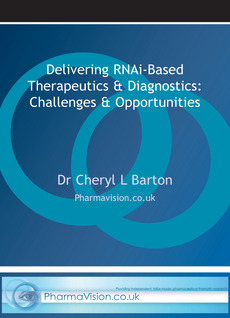Published Date: 01/07/2009
Category: Drug Delivery & Devices
Research Report Decription
This report gives in depth analysis of innovative drug delivery
technologies that are being applied to both innovative cancer therapies
and those that are currently in use. Innovative parenteral, oral and
transdermal delivery technologies are considered in the report and
forecasts given of the sales of products incorporating these
technologies.
Key Questions Answered:
- Which companies & academic institutes are actively involved in RNAi-based therapeutic research?
- What are the key areas of therapeutic focus for RNAi-based therapeutics in the near & long-term?
- What are the key obstacles companies & delivery technologists need to overcome to commercialize RNAi-derived therapies?
- How will delivery technologies drive the development of innovative RNAi-based therapies in thefuture?
- Which RNAi technologies & agents are likely to win in the near-term & long-term, & why?
- Where are the market opportunities now & in the future?
- When are RNAi-based medicines likely to reach the market?
- What do we predict will be the value of the RNAi-based therapeutics by 2015 & 2020?
Companies Mentioned:
RNAi therapeutic companies: AiRNA Pharmaceuticals, Allergan, AlnylamPharmaceuticals, Benitec, BioCandell Therapeutics, CalandoPharmaceuticals, Cenix BioScience, Cequent Pharmaceuticals, CopernicusTherapeutics, Dicerna Pharmaceuticals, Expression Genetics Corporation,General Research Laboratory, Intradigm Corporation, MDRNA, MirnaTherapeutics, MiRagen Therapeutics, Nikko Denko Technical Corporation,Opko Health, Oxford BioMedica, Polyplus Transfection, QuarkPharmaceuticals, Regulus Therapeutics, RXi Therapeutics, SantarisPharma, Senesco Technologies, Silence Therapeutics, Siranoamics,siRNAsense A/S, Sylentis Pharmaceuticals, Tacere Therapeutics, TargetedGenetics Corporation & Tekmira Pharmaceuticals Corporation.Antisense therapeutic companies: Isis Pharmaceuticals, LorusTherapeutics & Santaris Pharma.Pharmaceuticals & biotechnology companies: AstraZeneca, Bristol-Myers Squibb, Biogen Idec, Cubist Pharmaceuticals, Eli Lilly, Enzon,Genzyme, Kyowa Hakko Kirin, Merck & Co., Novartis, Oncolys BioPharma,Pfizer, Roche & Takeda.RNAi diagnostic companies: Asuragen Diagnostics, Exiqon Diagnostics &Rosetta Genomics
Paper Highlights:
- Since the 1990s scientists across the world have begun to harness the power of RNA interference (RNAi) to silence genes in a multitude of diseases. However, many challenges face those aiming to develop RNAi-based therapies including targeted delivery, the design and efficacy of gene silencing agents and the minimization of off-target and immunogenic effects.
- Today there are over 100 RNAi-based projects under investigation to treat autoimmune and inflammatory diseases, cancer, cardiovascular disease, CNS disorders,metabolic, ocular conditions, and viral infectious diseases.The majority of these projects are in the earliest discoverystages (36%) or in preclinical studies (54%). Of the projectsthat have reached clinical trials, only a handful have passedinitial Phase 1/2 testing, with a total of three beinginvestigated in Phase 2 studies.
- In 1H09 two late-stage ocular RNAi-based therapies, OpkoHealth’s bevasiranib and Allergan’s AGN-745, were terminated in late-stage clinical trials after the drugs failed to meet a key efficacy endpoint. This is a major set back formarket and raises questions regarding the potential ofunformulated siRNAs as therapeutics.
- This market continues to be driven by a greaterunderstanding of the genetic component of a broad range ofdiseases and the development of targeted carrier systems toensure efficient local, systemic and oral delivery of the RNAisilencing agents.
- Innovative structures and chemical modifications are beingexplored to improve stability, efficacy and delivery ofRNAi-based therapeutics and reduce off-target effects. Inaddition, a number of novel RNAi silencing agents have beenidentified with therapeutic and diagnostic potentialincluding dicer substrate RNA (disRNA) and anti-miRNAs.
- Despite these challenges and others, such as thecomplexities of regulation and intellectual property, thefield retains enormous potential to diagnose and treatdiseases with high unmet medical need. Specialists andacademics are working hard to find ways around thesehurdles in order to deliver a new generation of RNAi-based therapeutics and diagnostics.
- The market for RNAi-based therapeutics is forecast to growfrom 2013 onwards, as the first products enter the marketplace, to generate sales in excess of US$2.9 billion by2020. The first siRNA based therapeutics will capitalize onthe demand to treat viral infections and ocular conditionsand in the longer term companies will be able to targetniche areas of high unmet clinical need such as cancer,cardiovascular disease, metabolic disorders, inflammatory and neurological conditions.
